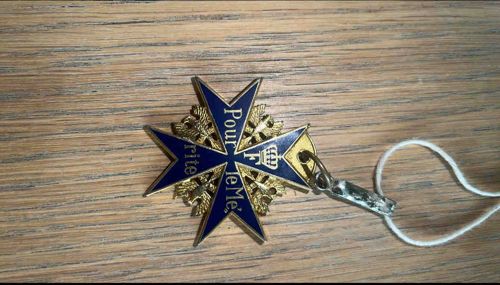
Replica of the Prussian Pour le Mérite (Blue Max)
The item depicted is a replica or reproduction of the Prussian Pour le Mérite, often referred to as the 'Blue Max.' It is a cross pattée, primarily characterized by its four arms broadening at the ends. The material appears to be a gilt metal, likely brass or bronze alloy, with a striking deep blue enamel infill on the surface of the cross arms. The edges of the cross are gold-toned, creating a contrast with the blue enamel. The central portion of the cross features intricate gold-toned detailing, including a crowned 'F' (for King Frederick the Great) on the top arm and the inscription 'Pour le Mérite' across the horizontal and lower arms, with 'Pour' on the left, 'le Mé' on the right, and 'rite' on the bottom. The inscription is in raised gold lettering. Between each arm of the cross, there are finely detailed golden eagles, a characteristic feature of the Pour le Mérite, though the detail of these eagles suggests it might be a contemporary reproduction rather than an original antique piece, as the crispness often seen in originals might be lacking. The reverse side, not fully visible, would typically mirror the front or have specific markings. The medal is attached to a small, worn metal clasp, through which a simple white string is threaded, suggesting it might be for display or sale as a collectible replica. There are visible signs of wear on the gilt finish, particularly on the edges and raised areas, consistent with handling or age. The enamel appears largely intact with no major chips or cracks visible, although some surface scratching might be present. The overall construction suggests an attempt to replicate the original historical artifact, but without clearer views of the reverse and more detailed material analysis, it's difficult to ascertain its exact manufacturing origin or the quality of its craftsmanship definitively beyond it being a commemorative or replica piece. Based on the visible quality and the presence of a simple string, it is likely a modern reproduction rather than an original 18th or 19th-century award.
AI-Generated Appraisal Disclaimer
Estimated Value
$50 - $100
Basic Information
Category
Military Medal/Order
Appraised On
December 3, 2025
Estimated Value
$50 - $100
Additional Details Provided By Owner
User Provided Information
The missing pour le merite that disappeared from Germany that is said to be owned by Noah Dohme that is the emperor of lixland which is 75 million square kilometers owned by Noah Dohme the emperor of lixland which is 18 years old
Item Description
The item depicted is a replica or reproduction of the Prussian Pour le Mérite, often referred to as the 'Blue Max.' It is a cross pattée, primarily characterized by its four arms broadening at the ends. The material appears to be a gilt metal, likely brass or bronze alloy, with a striking deep blue enamel infill on the surface of the cross arms. The edges of the cross are gold-toned, creating a contrast with the blue enamel. The central portion of the cross features intricate gold-toned detailing, including a crowned 'F' (for King Frederick the Great) on the top arm and the inscription 'Pour le Mérite' across the horizontal and lower arms, with 'Pour' on the left, 'le Mé' on the right, and 'rite' on the bottom. The inscription is in raised gold lettering. Between each arm of the cross, there are finely detailed golden eagles, a characteristic feature of the Pour le Mérite, though the detail of these eagles suggests it might be a contemporary reproduction rather than an original antique piece, as the crispness often seen in originals might be lacking. The reverse side, not fully visible, would typically mirror the front or have specific markings. The medal is attached to a small, worn metal clasp, through which a simple white string is threaded, suggesting it might be for display or sale as a collectible replica. There are visible signs of wear on the gilt finish, particularly on the edges and raised areas, consistent with handling or age. The enamel appears largely intact with no major chips or cracks visible, although some surface scratching might be present. The overall construction suggests an attempt to replicate the original historical artifact, but without clearer views of the reverse and more detailed material analysis, it's difficult to ascertain its exact manufacturing origin or the quality of its craftsmanship definitively beyond it being a commemorative or replica piece. Based on the visible quality and the presence of a simple string, it is likely a modern reproduction rather than an original 18th or 19th-century award.
Get Your Items Appraised
Instant estimates of your treasures with AI-powered instant appraisals